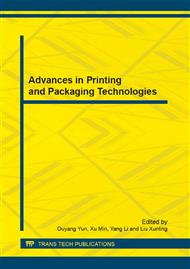p.518
p.523
p.527
p.532
p.537
p.543
p.547
p.551
p.557
Research on Formula of Dye-Based UV-Curable Ink for Inkjet
Abstract:
With the development of ink-jet technology and digital proofing, the application of UV-curable ink for inkjet printing has increasingly been concerned. The characteristics of UV-curable ink, such as fast-curing, non-blocking of nozzles, no evaporation of solvent make it possess obvious development predominance in the field of inkjet printing. The purpose of this study is to obtain a formula of dye-based UV-curable ink used indoors through tests, thus it will promote the application of UV-curable ink in the digital inkjet field. Based on the characteristics of indoor inkjet printing, we confirmed the category of raw materials in formula of dye-based UV-curable ink, such as base materials of vehicles, dye and photoinitiator. In the vehicle formula experiments, by using three types of optically active monomer with even experimental design, viscosity and surface tension as the indicators, we obtained the three types of vehicle optimum ratio suitable for the requirements of inkjet printing. In the formula experiments, ultraviolet light transmittance of dyes was tested firstly. With the ultraviolet absorption characteristics of photoinitiator, we confirmed the matching design of dye and photoinitiator. Based on the indicators of curing rate and color density, we obtained the optimum formula of the CMYK four-color UV rays curing ink by orthogonal experimental methods.
Info:
Periodical:
Pages:
537-542
Citation:
Online since:
December 2012
Authors:
Keywords:
Price:
Сopyright:
© 2013 Trans Tech Publications Ltd. All Rights Reserved
Share:
Citation:


